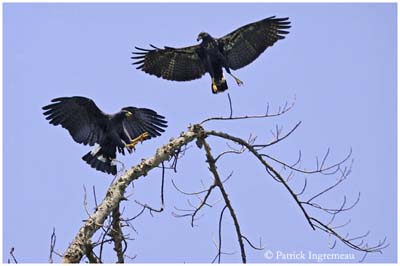
Great Black Hawk
Buteogallus urubitinga
Accipitriforme Order – Accipitridae Family
BIOMETRICS:
Length: 56-64 cm
Wingspan: 120-137 cm
Weight: 1100-1300 g
DESCRIPTION:
Great Black-Hawk is a large raptor with heavy body and long legs.
Adult male has black plumage on entire body, except the white basal half of tail, and white uppertail coverts. We can see a narrow white terminal band. Tail is fairly short.
When in flight, under wings show whitish bases on the first three primaries, and indistinct grey barring across flight feathers. Great Black-Hawk has very broad wings.
Head is black. Strong, hooked bill is black, with yellow cere. Lores are often yellow, but sometimes, they can be greyish. Eyes are dark brown. Legs and talons are yellow.
Both sexes are similar, with female slightly larger than male.
PROTECTION / THREATS / STATUS:
Great Black-Hawk populations have wide range and are classified as Least Concern. This species is uncommon on most parts of its range, but populations are stables in Argentina where it is not disturbed.
However, numbers decline in Mexico and Central America, due to habitat loss by clearing and deforestation.
Great Black-Hawk can be killed as trophy.
Fr: Buse urubu
All : Schwarzbussard
Esp : Busardo-negro Urubitinga
Ital : Poiana nera maggiore
Nd : Zwarte Arendbuizerd
Photographers:
Roger Ahlman
Pbase Galleries Peru and Ecuador
Patrick Ingremeau
TAMANDUA
Text by Nicole Bouglouan
Sources:
HANDBOOK OF THE BIRDS OF THE WORLD Vol 2 by Josep del Hoyo-Andrew Elliot-Jordi Sargatal - Lynx Edicions - ISBN: 8487334156
Wikipedia (Wikipedia, The Free Encyclopedia)
El Zoológico Electrónico (Damisela)

ADULT
AND
IMMATURE
We can find similar species: the Common Black-Hawk (Buteogallus anthracinus) which is smaller, and Solitary Eagle (Harpyhaliaetus solitarius) which is larger and rarer.
VOICE: SOUNDS BY XENO-CANTO
Great Black-Hawk utters distinctive piping, a high-pitched whistle as a scream “ooo-wheeeeeeuur”, while soaring or when perched.
HABITAT:
Great Black-Hawk is often seen near water, but it is rather an inland bird than coastal. It lives in forests and open woodlands near water, and can be seen, but uncommon, in forest edges, swampy woodlands, mangroves and savannahs with forest patches and water. It can be found from sea level up to 1600 metres of elevation.
RANGE:
Great Black-Hawk is resident from Mexico, through Central America to Peru, Trinidad and northern Argentina.
BEHAVIOUR:
Great Black-Hawk has wide range of preys which often hunt on foot. It is often seen soaring above woodlands, probably searching for preys such as reptiles, rodents, birds and fishes.
Its long, strong legs allow the bird to walk easily on the ground for hunting reptiles, large insects, lizards and frogs.
It can also hunt from perch, searching for prey on the ground or in water. When prey is detected, it dives and pursues it. It also waits for preys at the edges of fires.

In breeding period, we can see some displays and courtship behaviour, with both male and female soaring together, and birds with nest materials or prey at eventual nest-site.
Great Black-Hawk is resident in its range and breeding species. It is usually seen alone outside breeding season.
FLIGHT:
Great Black-Hawk often soars above its habitat for hunting or displays. When in flight, we can see the small white patches on primaries under its broad wings.

REPRODUCTION:
Great Black-Hawk nests up in trees, at about 20 to 22 metres above the ground, near watercourses or marshes.
Nest is a bulky platform made with strong sticks.
Female lays usually one single white egg, sometimes two. Eggs are marked with dark spots or streaks. Incubation lasts about 40 days, mainly by female.
Young are fed by both parents with several kinds of foods. Poisonous snakes are brought at nest with head removed. They are also fed with amphibians, small mammals, birds and insects, with more amphibians and reptiles than other items.
DIET:
Great Black-Hawk feeds mainly on small mammals, birds, reptiles such as lizards or snakes, fish, crabs, large insects, carrion, sometimes poultry, and fruits.


